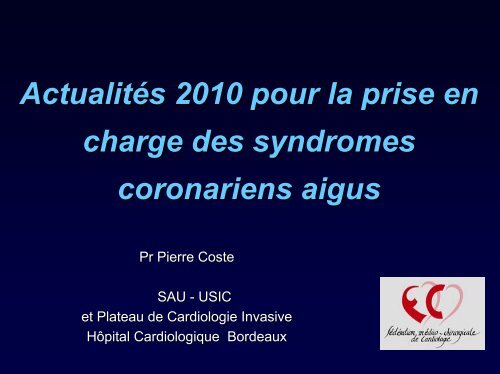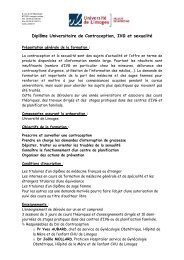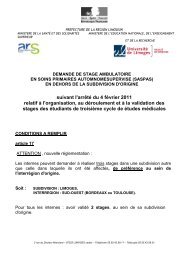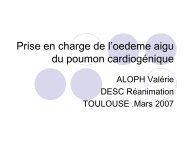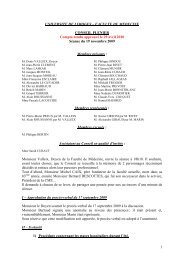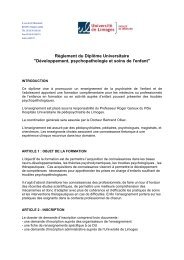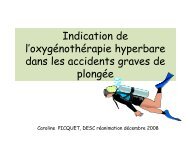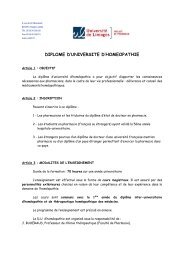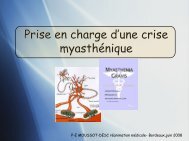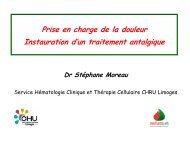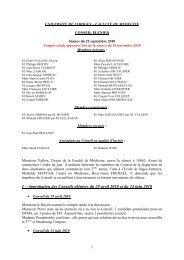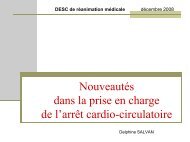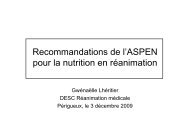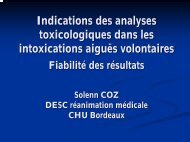Actualités dans la gestion des syndromes coronariens aigus
Actualités dans la gestion des syndromes coronariens aigus
Actualités dans la gestion des syndromes coronariens aigus
Create successful ePaper yourself
Turn your PDF publications into a flip-book with our unique Google optimized e-Paper software.
<strong>Actualités</strong> s 2010 pour <strong>la</strong> prise en<br />
charge <strong>des</strong> <strong>syndromes</strong><br />
<strong>coronariens</strong> <strong>aigus</strong><br />
Pr Pierre Coste<br />
SAU - USIC<br />
et P<strong>la</strong>teau de Cardiologie Invasive<br />
Hôpital Cardiologique Bordeaux
Recommandations HAS
douleur thoracique<br />
douleur persistante<br />
pas de douleur<br />
ECG<br />
Echocardiographie<br />
douleur < 20 min<br />
<br />
douleur prolongée<br />
Troponine I/T<br />
ECG<br />
Imagerie de <strong>la</strong> perfusion myocardique
IRM chez les patients avec myonécrose et<br />
coronaires angiographiquement « normales »<br />
N = 108 pts<br />
Infarctus 30%<br />
Myocardite 24%<br />
Tako-Tsubo 21%<br />
Myoc hypertrophique 1%<br />
IRM « normale » 24%<br />
Harcaut et al submitted
Recommandations Européennes<br />
(ESC 2007) pour <strong>la</strong> prise en charge d’une<br />
suspicion de SCA<br />
STEMI<br />
Urgente<br />
Évaluation<br />
- douleur<br />
- probabilité<br />
coronaropathie<br />
-ECG<br />
SCA<br />
possible<br />
Validation<br />
- réponse aux traitements<br />
antiangineux<br />
-marqueurs biologiques<br />
(troponines, MB-CK, BNP)<br />
- ECG n°2<br />
- Échocardiographie<br />
- Score de risque (GRACE)<br />
- Risque hémorragique<br />
Rapide < 72 h<br />
Non coronarien<br />
Non urgent<br />
/ électif<br />
Coronarographie
Recommandations ESC 2008<br />
pour <strong>la</strong> prise en charge<br />
<strong>des</strong> SCA avec sus-déca<strong>la</strong>ge de ST
Le seul objectif du traitement de<br />
l’infarctus avec sus ST : le dé<strong>la</strong>i de<br />
désobstruction coronaire<br />
• Angiop<strong>la</strong>stie primaire chaque fois que possible<br />
• Fibrinolyse pour STEMI < 2 h<br />
• Pas d’angiop<strong>la</strong>stie < 3 h systématique après <strong>la</strong> fibrinolyse ()<br />
• Angiop<strong>la</strong>stie « facilitée » par l’abciximab si STEMI à haut risque
One-year mortality, %<br />
Symptom Onset to Balloon Time and<br />
Mortality in Primary PCI for STEMI<br />
12<br />
10<br />
8<br />
6<br />
4<br />
6 RCTs of Primary PCI by Zwolle Group 1994 – 2001<br />
N = 1791<br />
P < 0.0001<br />
2<br />
RR = 1.08 [1.01 – 1.16] for each 30 min de<strong>la</strong>y<br />
(P = 0.04)<br />
0 0 60 120 180 240 300 360<br />
Symptoms to balloon inf<strong>la</strong>tion (minutes)<br />
DeLuca et al. Circu<strong>la</strong>tion<br />
2004;109:1223.
Reperfusion Therapy:<br />
Important Time Lines<br />
Onset<br />
of STEMI<br />
FMC Start lytic<br />
Reperfusion<br />
Onset<br />
of STEMI<br />
“PCI-re<strong>la</strong>ted de<strong>la</strong>y”<br />
FMC<br />
Reperfusion<br />
Balloon<br />
Sheath<br />
• Patient-dependent<br />
• (Organization-dependent)<br />
• Organization-dependent<br />
FMC:First Medical Contact
Recommandations Européennes pour les SCA<br />
avec sus-déca<strong>la</strong>ge de ST (2008)
Stratégie de reperfusion d’un SCA ST+ non compliqué avant <strong>la</strong> cardiologie<br />
SCA ST+<br />
PORTE à PORTE * < 45 min<br />
Signes < 3h<br />
Choix<br />
Signes > 3h et < 12h<br />
PORTE à PORTE * > 45 min ou<br />
Dé<strong>la</strong>i Porte Cardio – Ballon non estimable<br />
Signes < 3h<br />
Signes > 3h et < 12h<br />
Stratégie identique<br />
CI<br />
à<strong>la</strong><br />
FIB<br />
CI<br />
à<strong>la</strong><br />
FIB<br />
FIB<br />
Si échec<br />
fibrinolys<br />
e<br />
PCI<br />
PCI<br />
PCI<br />
PCI<br />
Si échec<br />
fibrinolyse<br />
FIB<br />
Centre de cardiologie interventionnelle<br />
*Le dé<strong>la</strong>i PORTE à PORTE doit s’intégrer <strong>dans</strong> le dé<strong>la</strong>i global de prise en charge qui ne doit pas être supérieur à 90 m<br />
TL : Thrombolyse – APL : angiop<strong>la</strong>stie – CI : contre indication
Reperfusion Therapy<br />
Recommendations C<strong>la</strong>ss LOE<br />
• Indicated in all pts with chest pain/discomfort of < 12 h<br />
and with persistent ST-segment elevation or (presumed)<br />
new LBBB<br />
I<br />
A<br />
• Should be considered if there is clinical and/or ECG<br />
evidence of ongoing ischaemia if symptoms started<br />
> 12 h before<br />
IIa<br />
C<br />
• Reperfusion (PCI) in stable pts presenting > 12 h to 24 h<br />
after symptom onset<br />
IIb<br />
B<br />
• PCI of totally occluded infarct artery in stable pts<br />
without signs of ischaemia > 24 h after symptom onset<br />
III<br />
B
Angiography after Fibrinolytic Therapy<br />
Recommendations C<strong>la</strong>ss LOE<br />
Evidence of failed fibrinolysis or uncertainty about success:<br />
immediate<br />
IIa<br />
B<br />
Recurrent ischaemia, reocclusion after initial successful<br />
fibrinolysis: immediate<br />
I<br />
B<br />
Evidence of successful fibrinolysis: within 3 to 24 h after<br />
start of fibrinolytic therapy<br />
IIa<br />
A<br />
In unstable patients who did not receive reperfusion<br />
therapy: immediate<br />
I<br />
C<br />
In stable patients who did not receive reperfusion therapy:<br />
before discharge<br />
IIb<br />
C
Primary PCI: Adjunctive Therapies<br />
Recommendations C<strong>la</strong>ss LOE<br />
• Antip<strong>la</strong>telet co-therapy<br />
– Aspirin<br />
– NSAID and COX-2 selective inhibitors<br />
– Clopidogrel loading dose<br />
– GPIIb/IIIa antagonist<br />
» abciximab<br />
» tirofiban<br />
» eptifibatide<br />
• Antithrombin co-therapy<br />
– heparin<br />
– bivalirudin<br />
– fondaparinux<br />
• Adjunctive devices<br />
– Thrombus aspiration<br />
I<br />
III<br />
I<br />
IIa<br />
IIb<br />
IIb<br />
I<br />
IIa<br />
III<br />
IIb<br />
B<br />
B<br />
C<br />
A<br />
B<br />
C<br />
C<br />
B<br />
B<br />
B
Fibrinolytic Therapy:<br />
Antithrombotic Co-therapy<br />
Recommendations C<strong>la</strong>ss LOE<br />
• Antithrombin co-therapy<br />
– with altep<strong>la</strong>se, retep<strong>la</strong>se and tenectep<strong>la</strong>se:<br />
• enoxaparin i.v. bolus followed 15 min <strong>la</strong>ter by first s.c.<br />
dose; if age > 75 years no i.v. bolus and start with reduced<br />
first s.c. dose<br />
I<br />
A<br />
• if enoxaparin is not avai<strong>la</strong>ble: a weight-adjusted bolus of<br />
i.v. heparin followed by a weight adjusted i.v. infusion with<br />
first aPTT control after 3 h<br />
I<br />
A
Pre-hospital thrombolysis vs primary PCI<br />
French Nationwide USIC 2000 registry (n=1922)<br />
%<br />
100<br />
95<br />
90<br />
85<br />
80<br />
75<br />
Age-adjusted survival (%)<br />
P
Thrombolysis vs primary PCI : 1 Yr Mortality in the<br />
French Nationwide FAST-MI 2005 registry<br />
(n=1714)<br />
• Time to therapy :<br />
– THR 130 min vs PPCI 300 min<br />
• Following thrombolysis : coronary<br />
angiogram 94 % + PCI (84%)<br />
Danchin Circu<strong>la</strong>tion 2008
Time de<strong>la</strong>ys and impact of PCI:<br />
importance of initial IRA patency<br />
16<br />
One-year Mortality<br />
14<br />
12<br />
10<br />
8<br />
6<br />
4<br />
p= NS p= 0.013<br />
5,3<br />
5,9<br />
5,5<br />
4,1<br />
2,7<br />
9,2<br />
12,7<br />
6<br />
2<br />
0<br />
0<br />
TIMI 2-3 TIMI 0-1<br />
N= 470 N= 1321<br />
De Luca et al. JACC 2003
Peut on améliorer les dé<strong>la</strong>is <br />
% de dé<strong>la</strong>is conformes aux recommandations<br />
Semaine<br />
100<br />
90<br />
80<br />
70<br />
60<br />
% 50<br />
40<br />
30<br />
20<br />
10<br />
0<br />
D1 : Douleur-SMUR<br />
D2 : Dé<strong>la</strong>i transfert SMUR-SU<br />
D3 : Entrée administrative<br />
D4 : Dé<strong>la</strong>i de réalisation ECG<br />
D5 : Dé<strong>la</strong>i de transfert en salle de KT<br />
D6 : Dé<strong>la</strong>i de préparation en salle<br />
D7 : Dé<strong>la</strong>i total de préparation<br />
D8 : Durée de l’intervention<br />
D1 D2 D3 D4 D5 D6 D7 D8<br />
De<strong>la</strong>is<br />
Week-end<br />
pourcentage de dé<strong>la</strong>is moyens conformes<br />
2007<br />
2009
PPCI or fibrinolysis : baseline mortality<br />
risk is a determinant of choice<br />
Tarantini Eur Heart J 2010;31:676
Décès, FV, choc cardiogénique à J90<br />
%<br />
hémorragies majeures (TIMI)<br />
18<br />
N = 806<br />
N = 818<br />
N = 828<br />
12<br />
10,7<br />
10,5<br />
9,8<br />
6<br />
2,6<br />
4,1<br />
4,8<br />
0<br />
angiop<strong>la</strong>stie<br />
avec abciximab<br />
en salle<br />
angiop<strong>la</strong>stie<br />
facilitée avec<br />
abciximab<br />
angiop<strong>la</strong>stie<br />
facilitée avec<br />
retep<strong>la</strong>se + abciximab
AHA Guidelines Circu<strong>la</strong>tion nov 2009
Clopidogrel response variability for loading doses<br />
(300 vs 600 mg)<br />
Patients (%)<br />
33<br />
30<br />
27<br />
24<br />
21<br />
18<br />
15<br />
12<br />
9<br />
6<br />
3<br />
0<br />
Resistance = 28% (300 mg)<br />
Resistance = 8% (600 mg)<br />
300 mg clopidogrel<br />
600 mg clopidogrel<br />
≤−30 (−20,−10] (0,10] (20,30] (40,50] (60,70]<br />
(−30,−20] (−10,0] (10,20] (30,40] (50,60] > 70<br />
Δ A (5 μM ADP-induced Aggregation) at 24 h<br />
Gurbel PA J Am Coll Cardiol. 2005;45:1392
Inhibition of P<strong>la</strong>telet Aggregation<br />
(IPA) at 24 Hours (Healthy Volunteers)<br />
Inhibition of p<strong>la</strong>telet aggregation (%)<br />
100.0<br />
80.0<br />
60.0<br />
40.0<br />
20.0<br />
0.0<br />
-20.0<br />
Interpatient variability<br />
Response to<br />
clopidogrel<br />
*Responder = ≥25% IPA at 4 and 24 hours.<br />
Brandt et al. Am Heart J. 2007;153:66e9-66e16.<br />
Clopidogrel responder<br />
Clopidogrel nonresponder<br />
Response to<br />
prasugrel<br />
Interpatient<br />
variability
15<br />
TRITON study : Primary Endpoint CV<br />
Death,MI,Stroke<br />
Primary Endpoint (%)<br />
10<br />
5<br />
HR 0.77<br />
P=0.0001<br />
HR 0.80<br />
P=0.0003<br />
Clopidogrel<br />
Prasugrel<br />
12.1%<br />
(781)<br />
9.9%<br />
(643)<br />
HR 0.81<br />
(0.73-0.90)<br />
P=0.0004<br />
NNT= 46<br />
0<br />
ITT= 13,608 LTFU = 14 (0.1%)<br />
0 30 60 90 180 270 360 450<br />
Days Wiviott N Engl J Med 2007;357:2001
Ba<strong>la</strong>nce of Efficacy and Safety<br />
Endpoint (%)<br />
15<br />
10<br />
5<br />
0<br />
CV Death / MI / Stroke<br />
TIMI Major<br />
NonCABG Bleeds<br />
Clopidogrel<br />
Prasugrel<br />
Prasugrel<br />
Clopidogrel<br />
0 30 60 90 180 270 360 450<br />
Days<br />
12.1<br />
9.9<br />
2.4<br />
1.8<br />
138<br />
events<br />
HR 0.81<br />
(0.73-0.90)<br />
P=0.0004<br />
NNT = 46<br />
35<br />
events<br />
HR 1.32<br />
(1.03-1.68)<br />
P=0.03<br />
NNH = 167
* Range ±7 7 days<br />
3602 pts with STEMI<br />
R<br />
1:1<br />
Randomized<br />
UFH +<br />
GP IIb/IIIa<br />
N=1802<br />
Bivalirudin<br />
Monotherapy<br />
N=1800<br />
9<br />
15<br />
• • • Withdrew • • •<br />
• • • Lost to FU • • •<br />
10<br />
13<br />
30 day FU*<br />
N=1778<br />
(98.7%)<br />
N=1777<br />
(98.7%)<br />
ITT popu<strong>la</strong>tion<br />
N=1802 N=1800
Primary Outcome Measures (ITT)<br />
Diff = -2.9% [-4.9,-0.8]<br />
RR = 0.76 [0.63,0.92]<br />
P NI ≤ 0.0001<br />
sup<br />
= 0.006<br />
P sup<br />
Diff = -3.3% [-4.0,-1.6]<br />
RR = 0.60 [0.46,0.77]<br />
P NI ≤ 0.0001<br />
sup<br />
≤ 0.0001<br />
P sup<br />
Diff = 0.0% [-1.6,1.5]<br />
RR = 0.99 [0.76,1.30]<br />
sup<br />
= 1.00<br />
P sup<br />
1° endpoint 1° endpoint<br />
*Not re<strong>la</strong>ted to CABG<br />
**MACE = All cause death, reinfarction, ischemic TVR or stroke
1-Year Death or Reinfarction<br />
Death or MI (%)<br />
Number at risk<br />
Bivalirudin alone<br />
Heparin+GPIIb/IIIa<br />
10<br />
9<br />
8<br />
7<br />
6<br />
5<br />
4<br />
3<br />
2<br />
1<br />
0<br />
Bivalirudin alone (n=1800)<br />
Heparin + GPIIb/IIIa (n=1802)<br />
4.5%<br />
3.8%<br />
∆ = 0.7%<br />
P=0.30<br />
0 1 2 3 4 5 6 7 8 9 10 11 12<br />
Time in Months<br />
HR [95%CI] =<br />
0.77 [0.61, 0.98]<br />
P=0.04<br />
1800 1670 1638 1617 1469<br />
1802 1648 1617 1593 1431<br />
8.5%<br />
6.6%<br />
∆ = 1.9%
Post-Conditioning approach<br />
to reduce infarct size<br />
Occluded<br />
coronary artery<br />
Reperfusion<br />
Control<br />
Direct stenting<br />
1’ 1’ 1’ 1’<br />
Postcond<br />
1’<br />
1’<br />
1’<br />
1’<br />
Balloon inf<strong>la</strong>tions - def<strong>la</strong>tions<br />
Staat et al. Circu<strong>la</strong>tion. 2005;112:2143-2148
CK release during reperfusion<br />
CK release (AUC: arbitrary units)<br />
5000<br />
4000<br />
3000<br />
2000<br />
1000<br />
- 36 % (p < 0.05)<br />
Control<br />
Post-Cond<br />
0<br />
Adm.<br />
PTCA<br />
4h 8h 24h 48h 72h<br />
Reperfusion<br />
Staat et al. Circu<strong>la</strong>tion. 2005;112:2143-2148
Recommandations ESC 2007<br />
pour <strong>la</strong> prise en charge<br />
<strong>des</strong> SCA sans sus-déca<strong>la</strong>ge de ST
Recommandations Européennes<br />
(ESC 2007) pour <strong>la</strong> prise en charge d’une<br />
suspicion de SCA<br />
STEMI<br />
Urgente<br />
Évaluation<br />
- douleur<br />
- probabilité<br />
coronaropathie<br />
-ECG<br />
SCA<br />
possible<br />
Validation<br />
- réponse aux traitements<br />
antiangineux<br />
-marqueurs biologiques<br />
(troponines, MB-CK, BNP)<br />
- ECG n°2<br />
- Échocardiographie<br />
- Score de risque (GRACE)<br />
- Risque hémorragique<br />
Rapide < 72 h<br />
Non coronarien<br />
Non urgent<br />
/ électif<br />
Coronarographie
Prise en charge initiale du SCA sans sus-ST<br />
• Oxygène 4 – 8 l/min si SpO2 < 90%<br />
• Dérivés nitrés en sub-lingual ou IV (si PAS > 90 mm Hg)<br />
• Aspirine dose initiale 160-325 mg puis 75 mg/J<br />
• Clopidogrel dose de charge 600 mg puis 75 mg /J – Prasugrel <br />
• Anticoagu<strong>la</strong>tion selon <strong>la</strong> stratégie envisagée et le risque hémorragique<br />
– HNF IV 60 UI/kg (max 5000 UI) puis IVSE 12-15 UI/kg/h<br />
pour TCA à 1,5 – 2,5 x témoin<br />
– Fondaparinux SC 2,5 mg/j<br />
– Enoxaparine SC 1mg/kg x 2 /j<br />
– Daltéparine 120 UI/kg x 2 /j<br />
– Nadroparine 86 UI/kg x 2 /j<br />
– Bivalirudine 0,1 mg/kg IV bolus puis 0,25 mg/h IVSE<br />
• Béta-bloquant IV si HTA ou tachycardie sans signe d’insuffisance cardiaque<br />
• Antalgiques : morphine IV ou SC titrée (3 – 5 mg)<br />
• Atropine 0,5 – 1 mg IV si bradycardie ou ma<strong>la</strong>ise vagal
Critères pour le bi<strong>la</strong>n coronarographique<br />
Urgent<br />
< 120 minutes<br />
1- Angor réfractaire au<br />
traitement<br />
2- Angor récidivant sous<br />
traitement avec modifications<br />
de ST (ECG)<br />
3- Insuffisance cardiaque /<br />
choc<br />
4- TV ou FV<br />
Rapide < 72 h<br />
1- Élévation troponines<br />
2- Alternance de<br />
repo<strong>la</strong>risation ST ou onde T<br />
3- Diabète<br />
4- Insuffisance rénale (< 60<br />
ml/min)<br />
5- FEVG < 40%<br />
6- Angor instable post<br />
infarctus<br />
7- ATCD de pontage<br />
coronaire<br />
8- Score GRACE<br />
intermédiaire ou haut risque<br />
Non urgent<br />
1- Pas de récidive<br />
d’angor<br />
2- Pas d’insuffisance<br />
cardiaque<br />
3- Pas d’anomalies ECG<br />
(1 er et 2 ème tracé)<br />
4- Deux troponines (H0-<br />
H6) normales
Que faire <strong>des</strong> anti-GPIIB-IIIA et quand<br />
faire <strong>la</strong> coronographie
ACUITY – Primary Results<br />
UFH/Enoxaparin + GPI vs. Bivalirudin Alone<br />
UFH/Enoxaparin+GPI (N=4603)<br />
Bivalirudin alone (N=4612)<br />
30 day events (%)<br />
P NI<br />
P Sup<br />
NI
Potential Risks of Combining Different<br />
Antithrombotic Drugs<br />
Unfractionated<br />
Heparin<br />
(UHF)<br />
Low Molecu<strong>la</strong>r<br />
Weight Heparin<br />
(Enoxaparin sc)<br />
Fondaparinux<br />
Bivalirudin<br />
Half-Life<br />
3 Hrs 6 Hrs 4 Hrs 0.3 Hrs<br />
STEMI: 0.75 mg/kg bolus<br />
followed by infusion 1.75<br />
mg/kg/h<br />
Dose/Kg 30-120 mg/Kg 1 mg/Kg 2.5 mg sc<br />
NSTE-ACS: 0.1 mg/kg<br />
bolus followed by infusion<br />
0.25 mg/kg/h<br />
(if PCI, additional 0.5<br />
mg/kg IV bolus followed<br />
by infusion 1.75 mg/kg/h)<br />
Monitoring<br />
ACT/aPTT<br />
Factor X (not<br />
required)<br />
Not required<br />
ACT (not required)<br />
Inactivation<br />
Protamine<br />
Sulphate<br />
n.a.<br />
n.a.<br />
n.a.
96-Hour Primary Efficacy Results<br />
Routine Early<br />
Eptifibatide<br />
(n=4722)<br />
De<strong>la</strong>yed<br />
Provisional<br />
Eptifibatide<br />
(n=4684)<br />
OR<br />
(95% CI)<br />
Death, MI, RIUR, TBO 9.3% 10.0% 0.92 0.23<br />
(0.80-1.06)<br />
Death 0.8% 0.9% 0.96 0.87<br />
(0.62-1.50)<br />
Death or MI 7.5% 8.3% 0.89 0.13<br />
(0.77-1.04)<br />
Death, MI, RIUR 8.4% 9.4% 0.89 0.11<br />
(0.77-1.03 )<br />
MI, myocardial infarction; RIUR, recurrent ischemia requiring<br />
urgent revascu<strong>la</strong>rization; TBO, thrombotic bailout EARLY ACS NEJM 2009<br />
P
Small Molecule GP IIb/IIIa Inhibition in<br />
NSTE ACS<br />
PURSUIT<br />
PRISM<br />
PRISM PLUS<br />
Theroux<br />
PARAGON B<br />
PARAGON A<br />
0.88 (0.79-0.97)<br />
COMBINED 1998 (n = 23,967)<br />
ACUITY Timing<br />
EARLY ACS<br />
0.92 (0.82-1.01)<br />
0.89 (0.84-0.95)<br />
EARLY ACS + ACUITY<br />
COMBINED 2009 (n = 42,666)<br />
0.25 0.50 1.0 2.0 4.0<br />
Odds Ratio for 30-day Death or MI Re<strong>la</strong>tive to Control
ABOARD : Individual Ischemic Endpoints<br />
at 1 month<br />
%<br />
P=0.08<br />
P=0.09<br />
P=0.28<br />
P=0.32<br />
P=0.57<br />
P=0.62<br />
Montalescot JAMA 2009;302:947
En conclusion<br />
(en l’attente <strong>des</strong> recco 2011…)<br />
• Une stratégie…chirurgicale avec une prise en<br />
compte de <strong>la</strong> reperfusion<br />
• Un environnement pharmacologique<br />
– Plus puissant (prasugrel)<br />
– Plus modu<strong>la</strong>ble (bivalirudine)<br />
• Une évaluation du risque (scores) encore<br />
imparfaite pour une approche personnalisée


